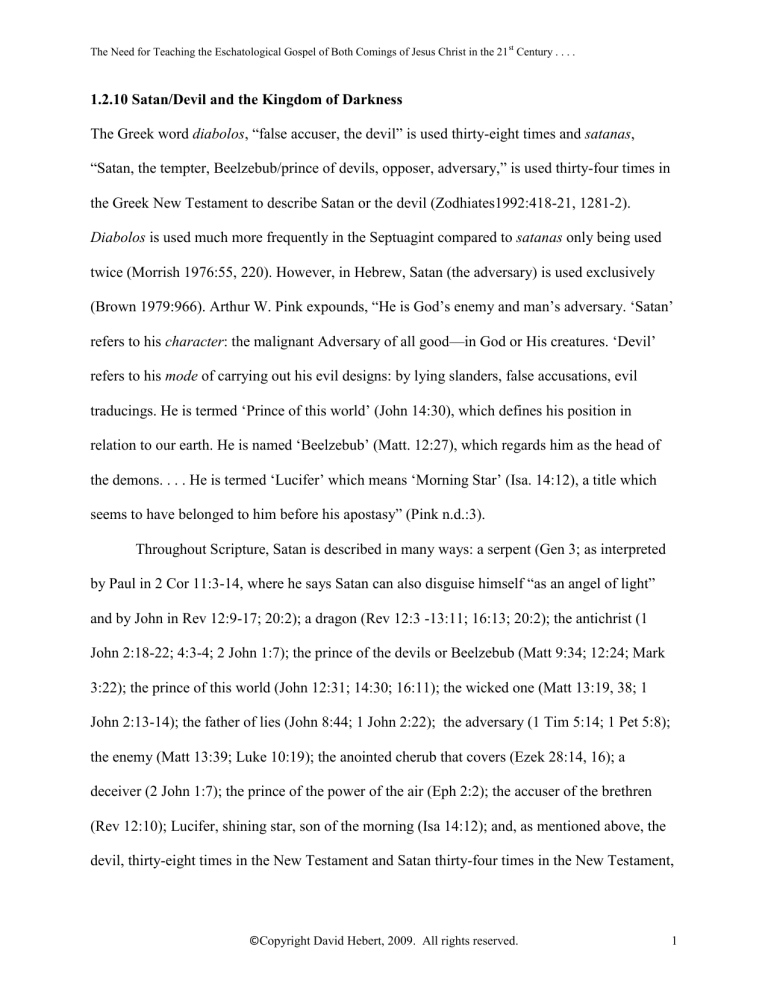
The Need for Teaching the Eschatological Gospel of Both Comings of Jesus Christ in the 21 st Century . . . . 1.2.10 Satan/Devil and the Kingdom of Darkness The Greek word diabolos, ―false accuser, the devil‖ is used thirty-eight times and satanas, ―Satan, the tempter, Beelzebub/prince of devils, opposer, adversary,‖ is used thirty-four times in the Greek New Testament to describe Satan or the devil (Zodhiates1992:418-21, 1281-2). Diabolos is used much more frequently in the Septuagint compared to satanas only being used twice (Morrish 1976:55, 220). However, in Hebrew, Satan (the adversary) is used exclusively (Brown 1979:966). Arthur W. Pink expounds, ―He is God‘s enemy and man‘s adversary. ‗Satan‘ refers to his character: the malignant Adversary of all good—in God or His creatures. ‗Devil‘ refers to his mode of carrying out his evil designs: by lying slanders, false accusations, evil traducings. He is termed ‗Prince of this world‘ (John 14:30), which defines his position in relation to our earth. He is named ‗Beelzebub‘ (Matt. 12:27), which regards him as the head of the demons. . . . He is termed ‗Lucifer‘ which means ‗Morning Star‘ (Isa. 14:12), a title which seems to have belonged to him before his apostasy‖ (Pink n.d.:3). Throughout Scripture, Satan is described in many ways: a serpent (Gen 3; as interpreted by Paul in 2 Cor 11:3-14, where he says Satan can also disguise himself ―as an angel of light‖ and by John in Rev 12:9-17; 20:2); a dragon (Rev 12:3 -13:11; 16:13; 20:2); the antichrist (1 John 2:18-22; 4:3-4; 2 John 1:7); the prince of the devils or Beelzebub (Matt 9:34; 12:24; Mark 3:22); the prince of this world (John 12:31; 14:30; 16:11); the wicked one (Matt 13:19, 38; 1 John 2:13-14); the father of lies (John 8:44; 1 John 2:22); the adversary (1 Tim 5:14; 1 Pet 5:8); the enemy (Matt 13:39; Luke 10:19); the anointed cherub that covers (Ezek 28:14, 16); a deceiver (2 John 1:7); the prince of the power of the air (Eph 2:2); the accuser of the brethren (Rev 12:10); Lucifer, shining star, son of the morning (Isa 14:12); and, as mentioned above, the devil, thirty-eight times in the New Testament and Satan thirty-four times in the New Testament, ©Copyright David Hebert, 2009. All rights reserved. 1 The Need for Teaching the Eschatological Gospel of Both Comings of Jesus Christ in the 21 st Century . . . . in addition to twenty-one times in the Old Testament (including fourteen times in Job while having a conversation with God-Elohim in heaven). Job is considered to be one of the oldest, if not the oldest, books of the Bible. If it was not written first, it certainly speaks of the patriarchal times in the Old Testament around the time of Abraham (LaSor, Hubbard and Bush 1996:471-4; Ryrie 1978:747). Therefore, it appears that Satan (the adversary or enemy) remains the most common usage, probably the best name for him and what will be used throughout the remainder of this thesis. Satan is a created being; most probably an anointed cherub, next in line under God Himself (Pink n.d. 14). He fell from grace with God and as a result of his pride, took a third of the angels with him and came to earth to usurp God‘s authority and steal, kill and destroy humanity, created in the image of God, through ―the gospel of Satan‖ (Pink n.d. 15-25, 32-40). He was said to rule over his own kingdom (Matt 12:26; Mark 3:23-27) and this world (John 12:31; 14:30; 16:11) by Jesus in the Gospels (Zodhiates 1992:392-4). This kingdom of darkness is the antithesis of Jesus‘ kingdom of light/heaven/God (Matt 8:11-12; 13:38-42; John 18:36; Acts 26:18; Col 1:13; 1 Thess 5:5; 1 John 1:5-6; Rev 16:10), is spiritual in nature and is described by the New Testament in Greek primarily by the word skotos meaning, ―darkness— physical, spiritual, place of infernal spirits; opposite of Christ; and opposite of phos—light, mentioned in Matt 4:16; Luke 1:79; John 3:19; Rom 2:19; 13:12; 1 Cor 4:51; Eph 5:8, 11.‖ On a much more limited scale, the kingdom of darkness is represented by the Greek word zophos, darkness of Tartarus or Gehenna, mentioned in 2 Peter 2:4, 17 and Jude 6, 13 (Zodhiates 1992:1298, 702). And again, as mentioned by Jesus in the Parable of the Tares/Weeds in Matthew 13:24-30, 36-43, this kingdom of Satan is allowed to coexist, and grow unhindered, alongside the kingdom of heaven/God until the ―harvest‖ at ―the end of the age‖ (or eschaton). ©Copyright David Hebert, 2009. All rights reserved. 2 The Need for Teaching the Eschatological Gospel of Both Comings of Jesus Christ in the 21 st Century . . . . There is a section of modern scholarship (developed by Rudolf Bultmann and related to his ―demythologizing‖ Scripture), that does not believe in a personal devil or Satan, or of anything supernatural that cannot be verified through scientific inquiry or method for that matter (Klein 1993:58). However, this belief acknowledges the presence of evil as a force which opposes God and the furtherance of His kingdom, but not in any personalized sense. If one uses Bultmann‘s concept to demythologize all the Old and New Testament references to Satan as a supernatural personage (along with the mentioning of all other supernatural occurrences; e.g., Moses and the children of Israel during the Exodus and in the wilderness, the dedication of Solomon‘s Temple, the ministries of Elijah and Elisha, and the ministries of Jesus and the Apostles), then one must also demythologize the very words of Jesus Himself regarding Satan as a personalized enemy (Matt 12:26; 13:19, 39; 25:41; Mark 3:23, 26; 4:15; Luke 8:12; 10:18; 11:18; 13:16; and John 8:44) and His own personal temptation by Satan in the wilderness (recorded in Matt 4:1-11; Mark 1:12-13 and Luke 4:1-13). This demythologizing method of interpreting these texts about Satan remains at the very edge (if not over the line) of orthodox grammatical-historical-literal biblical hermeneutics. Since this view comprises only an isolated, small section of modern biblical textual criticism, and is in direct opposition to the author‘s presuppositional hermeneutical approach to Scripture, it will not be pursued any further. Jesus, through the power (dunamis) and authority (exousia) of the kingdom of heaven/God (malkut shamayim) or the age to come (olam habbah) bound Satan‘s kingdom during his ministry on earth (Matt 4:23; 9:35; 12:29; Luke 10:18; John 12:31; Acts 10:38). Then, by His substitutionary, atoning and sacrificial death, burial and resurrection, Jesus defeated Satan and his kingdom in the spiritual realm (Matt 28:18; 1 Cor 15:24; 2 Cor 2:14; Eph 4:8; Col 2:10, 15). Finally at the Parousia, Jesus will completely and finally defeat Satan, in the physical as ©Copyright David Hebert, 2009. All rights reserved. 3 The Need for Teaching the Eschatological Gospel of Both Comings of Jesus Christ in the 21 st Century . . . . well as the spiritual realm, and will replace the kingdom of this world with the kingdom of Christ (Ps 2; 24:7-10; Rev 12:7-10; 19:11 – 20:3). Both Rudolf Otto, in his essay ―The Kingdom of God Expels the Kingdom of Satan‖ (1984), and Ladd, in his book A Theology of the New Testament (1974:65-9), explain that this shows the eschatological nature of the mission of Jesus’ First Advent, as well as the connection to the Parousia in the victory of the kingdom of God over the kingdom of Satan [emphasis added]. ©Copyright David Hebert, 2009. All rights reserved. 4


